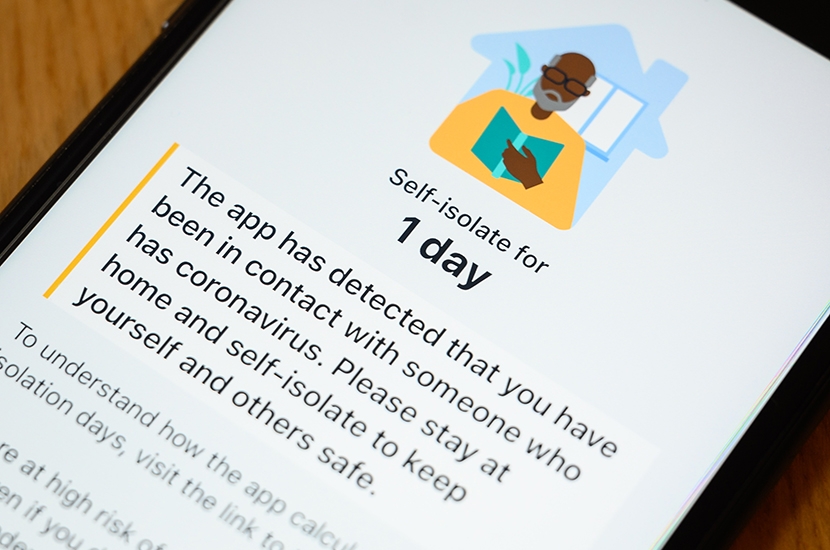Under what circumstances can a government restrict the liberty of the people? An example was given last year: in a public health emergency, to contain a pandemic which threatens to overrun the health service. Opinions may differ on how close we came to this in March 2020, but the question remains relevant now. Is there any realistic threat, today, of the NHS being overwhelmed? And if not, why is Test and Trace still pinging and confining thousands of people every day?
When the Test and Trace system was introduced in May last year, it was supposed to prevent another lockdown. In the absence of a vaccine (there was no guarantee at that stage that we would ever have one), the idea of tracking people who had come into close contact with someone who had tested positive, and making them isolate, was the best hope we had for resuming normal life. Ministers were assured that while this scheme was staggeringly expensive — £5 billion at the last count — it would prevent a second wave.
Since then several vaccines have been introduced and 86 per cent of the UK adult population now carry antibodies to the virus. The third wave of infections is (so far) leading to half as many hospitalisations as were envisaged by the Sage scenarios used to extend lockdown. Vaccinations have been so effective at preventing infection and illness among vulnerable older groups that, according to calculations by The Spectator, the average age of someone testing positive has fallen to 26. The people who are now contracting the virus are also highly unlikely to get seriously ill from it.
Failing to reform Test and Trace risks throwing good money after bad
We need to brace ourselves for far more infections — perhaps as many as three million. But the vast majority will be among the young, and either mild or asymptomatic. Just one in 20 cases at present is in the over-65s. Crucially, even the most pessimistic Sage model now suggests that thanks to the vaccines, Covid patients will occupy no more than 3 per cent of NHS beds. We have achieved our original aim when the first lockdown was implemented and people were ordered home: the health service will not be overwhelmed by this third wave.
There was an argument for delaying the 21 June reopening until we learnt more about the Indian variant and the efficacy of the vaccines against it. But recent data is encouraging. Despite this, Test and Trace is ‘pinging’ people as enthusiastically as ever. In the latest figures, for the week to 9 June, 108,000 people were identified for self-isolation, a rise of 171 per cent in three weeks.
And to what effect? A Sage committee admitted in September that it had only made a ‘marginal’ difference to infection rates. The system is said to have improved since then, yet it remains a remarkably crude way of trying to fight a virus which no longer poses the threat it once did.
Having blown so much money on Test and Trace, the government is now behaving as though it needs to justify the outlay. There are moves to turn the NHS app into an identity card and keep the project going. Yet week by week the costs of Test and Trace are adding up. Not only are thousands of contact-tracers being employed, but there are the economic, social and educational costs of ordering people to stay at home.
Failing to reform Test and Trace risks throwing good money after bad. The resources being sunk into the system would be much better used in tracking down people who have not yet been vaccinated (32 per cent of black over-fifties have not been jabbed, compared with 6 per cent of white) and finding out if anything would persuade them to have the jab. They could be offered a range of vaccines or given greater access to different vaccination centres. Vaccinators could be sent out to people’s homes if they are finding it difficult to travel.
It is time to scale back Test and Trace and adjust for new circumstances. If we are facing a third wave of mild infections, we cannot treat it like the first wave. At the very least, self-isolation orders should not be issued to those who, because of vaccination or prior infection, are unlikely to be infected. The US authorities have taken that view for months now. But there is another important point. If there is no longer a credible risk of Covid overwhelming the NHS, are there any moral grounds for the state to deprive anyone — vaccinated or not — of their liberty?
Of course, Covid is not finished with us yet. There will likely be thousands more deaths still to come, but this is also true of influenza and pneumonia. Covid now sits alongside these viruses, having been successfully downgraded by the vaccine.
The Prime Minister of Estonia observed this week that lockdown has demonstrated that ‘the urge for a strong hand or an authoritarian way of governing runs deep in our societies, even in some countries you would never believe’. It’s an important point. That’s why, as the vaccines continue to do their work, Test and Trace should be reformed so that it facilitates rather than hinders a return to normality.






Comments